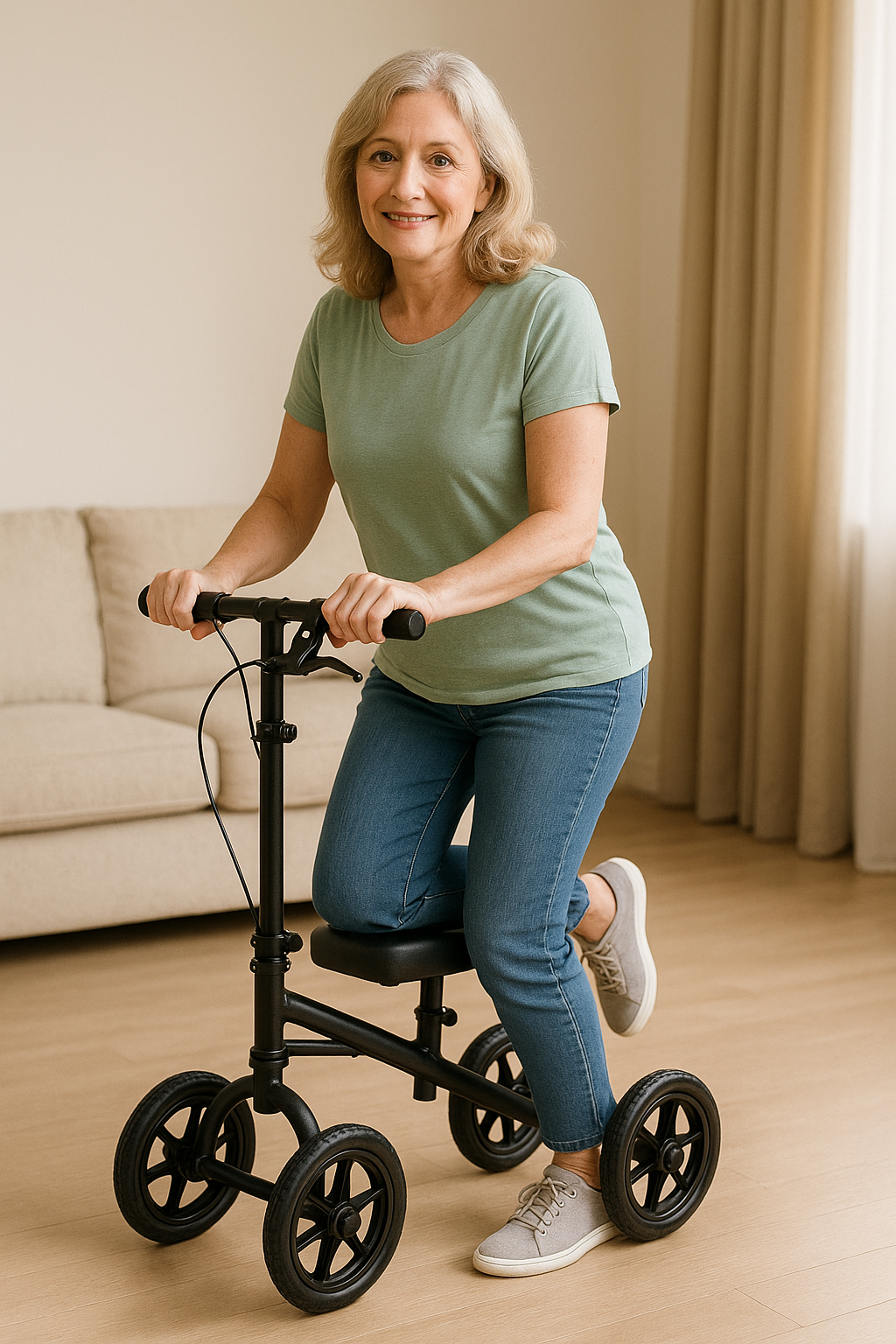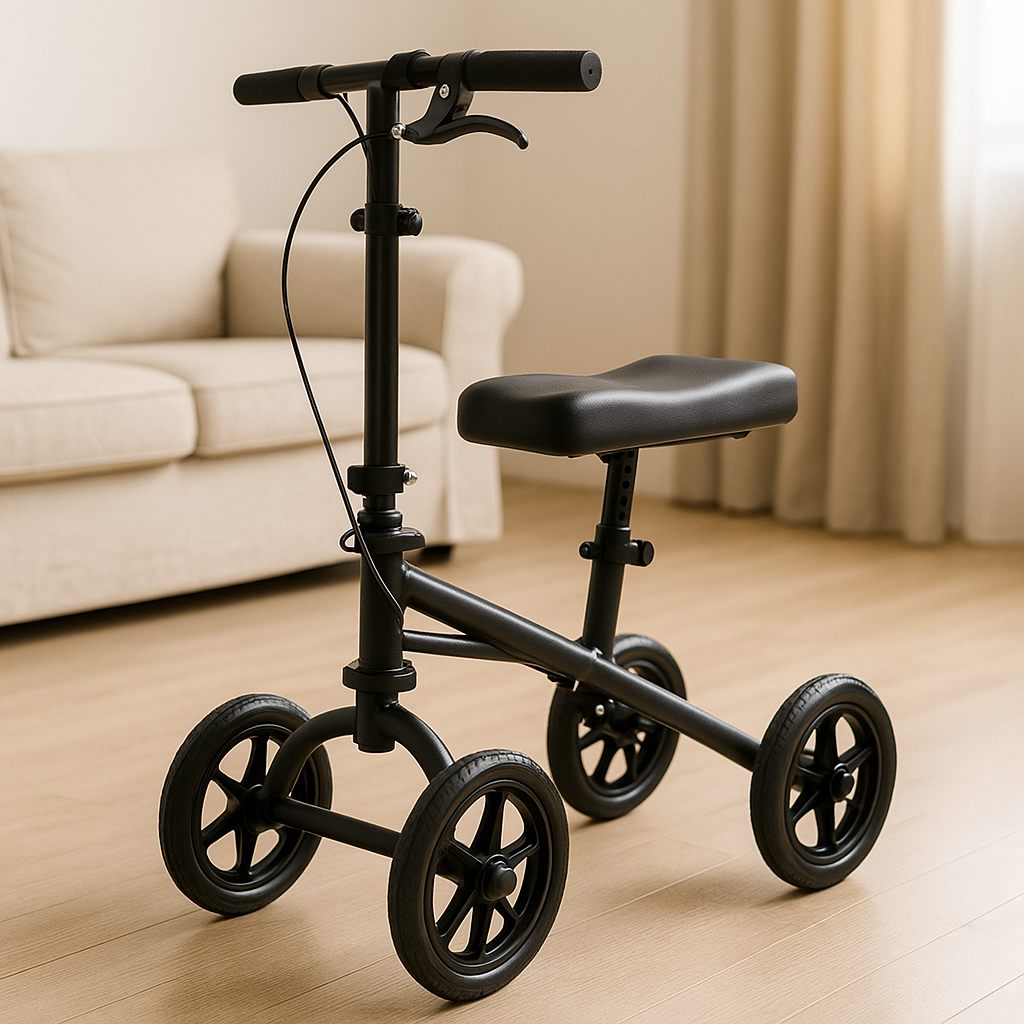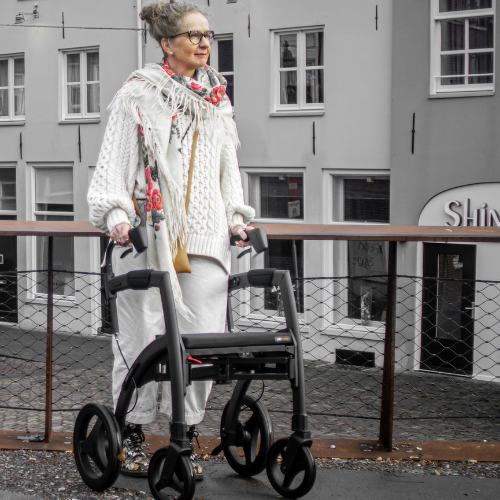If you’re recovering from a leg injury or surgery—or caring for someone who is—you may have heard about wheeled knee walkers. These innovative mobility aids offer a safe, stable, and comfortable alternative to crutches or traditional walkers. Whether you’re shopping for yourself or a loved one, understanding the different types of knee walker wheels, especially 3-wheel knee walker options and replacement wheels, is key to making the right decision.
In this guide, we’ll break down everything you need to know about knee walkers with wheels, including buying tips, wheel types, and when to replace them. Let’s roll into it!
A wheeled knee walker—also known as a knee scooter—is a mobility aid designed for people recovering from foot, ankle, or lower leg injuries. Instead of placing weight on the injured leg, the user rests their knee on a padded platform and pushes themselves forward using their healthy leg.

What Is a Wheeled Knee Walker?
Unlike crutches, which can strain your arms and shoulders, knee walkers with wheels offer improved balance and reduce fatigue. They’re especially helpful for seniors or anyone seeking a more stable way to move during recovery.
Benefits of Using a Knee Walker with Wheels
Knee walkers aren’t just about comfort—they can actually support faster healing and prevent accidents. Here’s why many doctors recommend them:
- Stability: Large, durable wheels offer balance even on uneven surfaces.
- Comfort: Padded platforms reduce strain on your knee and leg.
- Mobility: Easy to use indoors and outdoors.
- Safety: Built-in hand brakes offer secure stopping.
If you’re helping a parent or elder family member during recovery, a wheeled knee walker can be a game changer.

Types of Knee Walkers Based on Wheels
When selecting a knee walker, one of the most important factors to consider is the type of wheels it uses. The wheels determine how stable, maneuverable, and versatile the walker will be in different environments. Whether you need a device for indoor use, outdoor adventures, or both, understanding these types will help you choose the right knee walker with wheels.
1. 4-Wheel Knee Walkers – Maximum Stability and Support
These are the most popular and widely recommended types of wheeled knee walkers, especially for people who prioritize stability.
- Best For: Indoor and outdoor use, post-surgery recovery, elderly users
- Wheel Type: Usually four solid rubber or foam-filled wheels
- Why It’s Great: The four-wheel design provides excellent balance and prevents tipping, even when making turns.
- Drawback: Slightly larger turning radius compared to 3-wheel models
These are ideal for long-term recovery at home and are great for seniors or individuals who want peace of mind with added support. If you’re browsing for reliable knee walkers with wheels, this type should be your first consideration.
2. 3 Wheel Knee Walkers – Compact and Agile
A 3 wheel knee walker is perfect for people who need to navigate tight spaces like narrow hallways, small kitchens, or bathrooms.
- Best For: Small living areas, light indoor use
- Wheel Type: Three evenly spaced wheels—one in front and two at the back
- Why It’s Great: These are lightweight, foldable, and easy to maneuver in tight corners.
- Drawback: Slightly less stable than 4-wheel walkers, especially on uneven surfaces
If you’re someone who needs to move around a compact home or apartment, a 3-wheel model offers unmatched convenience. They’re also easier to transport in a car due to their lighter frame.
🟢 Pro Tip: Make sure to practice turning and braking before regular use to get used to the different balance of a 3-wheeler.
3. All-Terrain Knee Walkers – Built for the Outdoors
If you’re an active person or live in a rural area, an all-terrain knee walker may be the best fit.
- Best For: Outdoor use—parks, sidewalks, gravel paths, grass
- Wheel Type: Large air-filled or foam-filled wheels (8–12 inches)
- Why It’s Great: These wheels absorb shock, provide better traction, and make outdoor movement smooth and safe.
- Drawback: Heavier than standard models, and may require more storage space
These models often have knee walker wheels similar to those found on bicycles. They are rugged, reliable, and perfect for those who don’t want to be stuck indoors during recovery.
4. Swivel-Wheel Knee Walkers – Better Maneuverability
Swivel-wheel knee walkers add flexibility to your mobility. These are often used in medical settings or active households.
- Best For: Quick turns, navigating busy environments like hospitals or clinics
- Wheel Type: Swivel casters at the front, fixed rear wheels
- Why It’s Great: Allows smooth and tight turning without having to lift the front
- Drawback: Less control on slopes or uneven terrain
If turning ease is important to you, especially while working or multitasking at home, this style can greatly enhance your movement.
5. Fixed-Wheel Knee Walkers – More Control and Stability
Fixed-wheel models are typically recommended for those who need straightforward control and steady movement.
- Best For: First-time users, seniors, smooth indoor surfaces
- Wheel Type: All wheels are fixed (non-swiveling)
- Why It’s Great: Provides a stable and predictable path for movement, which is essential during the early phase of recovery
- Drawback: Slightly harder to turn; may require lifting and repositioning
This type is ideal if you’re helping an elderly parent or patient recover and want to minimize risk during daily use.
What to Look for in Knee Walker Wheels
When shopping for a knee walker with wheels, pay close attention to the wheel design. Here’s what matters:
- Material: Rubber or air-filled wheels provide smoother rides and better shock absorption than plastic ones.
- Size: Larger wheels (8”–12”) handle outdoor surfaces better.
- Stability: Look for anti-tip designs and wide bases for balance.
- Quiet Operation: Quality wheels should glide smoothly without noise.
The wheels make a big difference in comfort and safety, so don’t overlook them!
When to Replace Your Knee Walker Wheels
Just like any mobility aid, knee walker wheels can wear out over time. Here are signs you may need knee walker replacement wheels:
- Wheels wobble or feel loose
- Cracks, dents, or flat spots appear
- Squeaky or grinding noise during use
- Reduced traction on smooth floors
Replacement wheels are available for most models and are usually easy to install. Keeping your walker in top shape ensures safety—especially for elderly users.
Top Tips for Buying a Wheeled Knee Walker:
Before you make a purchase, keep these expert tips in mind:
- ✅ Choose a model with adjustable height settings for the handlebars and knee platform.
- ✅ Look for foldable designs if storage or travel is important.
- ✅ Ensure the walker supports your weight comfortably.
- ✅ Test the braking system—dual brakes are safer.
- ✅ A 3 wheel knee walker is great for smaller living spaces.
Remember: Comfort and safety should always come first, especially for seniors or post-surgery recovery.
✅ Final Thoughts: Mobility That Moves With You
A wheeled knee walker can be an essential part of a safe and smooth recovery journey. Whether you choose a 3-wheel knee walker for tight spaces or need replacement wheels for your current model, understanding the features and benefits makes it easier to pick the right one.
Want to explore more senior-friendly mobility options?
👉 Check out our latest guide: Top 10 Walkers for Seniors in 2025 – Your Ultimate Buying Guide
At Safe Elder Life, we’re committed to helping seniors and caregivers make informed decisions for better living.
Frequently Asked Questions (FAQ)
Q1: Can I use a wheeled knee walker outdoors?
Yes! Many models are designed for both indoor and outdoor use. Look for large, all-terrain wheels.
Q2: How long do knee walker wheels last?
With regular use, wheels can last 3–6 months or more. Check for wear signs regularly.
Q3: Are 3-wheel knee walkers safe?
They’re safe for most indoor uses and small spaces, but may be less stable than 4-wheel models on rough terrain.
Q4: What size wheels are best for knee walkers?
Wheels between 8” and 12” are ideal for mixed-use. Larger wheels are better for outdoor surfaces.



